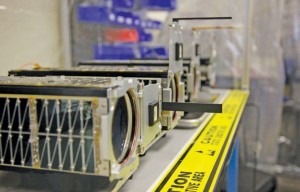All for real, and well within reach
Apart from space research organisations like ISRO, NASA and DARPA, which have successfully launched small satellites of all scales, private companies are also investing heavily in this area and are now expecting great returns by contracting earth imagery data to customers.
[stextbox id=”info” caption=”Wanna play space blocks?”]
CubeSat, developed over a decade ago by professors from Stanford University and California Polytechnic State University to advance satellite design learning, has now become the de facto standard for building small satellites—forming the basis of several small satellites being built by NASA, private companies, and start-ups too!
The CubeSat is basically a standardised module, shaped as a cube with 10cm edges and weighing approximately 1.33 kg. It can be fitted with the required instruments and launched into space. A small satellite might consist of one or more CubeSats as building blocks, and it is common practice to describe micro and nano satellites by the number of CubeSat units they contain (e.g., Planet Labs’ test satellites sent up in April 2013 were 3U-CubeSats). Generally, satellites may be 1U, 2U, 3U or 6U. CubeSat-based satellites are deployed from a standard poly-picosatellite orbital deployer (P-POD). Endorsing CubeSat’s popularity as a building block of research spacecrafts, NASA’s CubeSat Launch Initiative (CSLI) provides opportunities for small satellite payloads to fly on rockets planned for upcoming launches. These CubeSats are flown as auxiliary payloads on previously planned missions.
CubeSat.org, an active non-profit organisation, continues to provide the community with not just a standard physical layout, design guidelines and a standard, flight-proven deployment system (P-POD), but also coordination of the required documents and export licences, integration and acceptance testing facilities with formalised schedules, shipment of flight hardware to the launch site and integration to the LV, and confirmation of successful deployment and telemetry information.
[/stextbox]
Talking about future plans at Planet Labs, Schingler reports, “We are launching a commercial constellation of 28 satellites at the end of the year. They will be taking photos of the earth. We hope to accurately assess changing landscapes. Our imagery will be an entirely new data layer. We hope to innovate at every part of the product to streamline delivery of imagery to our partners and customers. Currently, the average person doesn’t know what he or she can do with frequently-updated information about the changing planet. This shift in the industry will open up satellite imagery to more engineers and small tech firms.”

After successfully launching two experimental satellites, Planet Labs is confident about launching the 28-satellite constellation together on an Antares rocket, a new launcher built by the US-based Orbital Sciences Corporation, by the end of this year. The CubeSat-based, solar-powered satellites will form a tilted ring around the earth, and orbit at an altitude of 400 km. Since the satellites have no propulsion systems, they are likely to lose speed in two to five years, after which they will fall towards Earth and burn up, making way for a new constellation. While in operation, they will send their images to three or more ground stations, where the data will be processed and uploaded for customers to use.
The other key player in this space, is US-based Skybox Imaging, an information and analytics company that also promises reliable and frequent high-resolution imagery including what it claims to be the first-ever HD video of the earth. Skybox will be using a constellation of over 24 microsatellites, of which the first two are likely to be launched later this year using Virgin Galactic’s LauncherOne launch vehicle. (According to Wikipedia, “Virgin Galactic is a company within Richard Branson’s Virgin Group, which plans to provide suborbital spaceflights to space tourists, suborbital launches for space science missions and orbital launches of small satellites.”)
With small satellites becoming so popular, launch facilities are also emerging as a good business! Virgin Galactic’s LauncherOne, which can launch payloads of 100 kg into low-earth orbit, is one of the most talked-about facilities. While it might take some months to get into operation, several US-based companies, including GeoOptics, Skybox Imaging, Spaceflight Services and Planetary Resources, are said to have already contracted LauncherOne. Plus, Surrey Satellite Technology and Sierra Nevada Space Systems, the two largest manufacturers of small satellites, are also said to be developing satellite buses optimised to the design of LauncherOne. US-based Garvey Spacecraft, too, recently received funding to develop a clustered nano/microsatellite launch vehicle capable of delivering 20kg payloads into 450km circular orbits, based on its Prospector 18 suborbital launch vehicle technology. Boeing is also working on an air-launched three-stage-to-orbit launch vehicle concept capable of launching small payloads of 45 kg into low-earth orbit.






